
|
POOR RAINFALL PERFOMANCE LIKELY TO AFFECT 2002/03 CROP PRODUCTION
The 2002/03 southern Africa rainfall season typically starts in October, with early September rains falling in some areas. The season, and associated cropping activities, start in the south and move gradually north. In a normal season, planting should begin in South Africa, Swaziland and Lesotho in October, and in northern Mozambique and Malawi in December. As seen in the satellite imagery below, overall rainfall in October was above normal except in Swaziland, Lesotho and key maize producing areas of South Africa, delaying planting in these areas. During the first ten days of November, good rains fell over most of Zambia, Zimbabwe and southern and central Mozambique, marking the start of the planting season in these areas. This was followed by nearly four weeks of unseasonably dry conditions from mid-November to mid-December, which wilted young plants and halted germination in many areas. Only in the second week of December did the rains resume in most of the region. In Lesotho, unseasonably late frosts in November caused additional damage to recently planted crops.
There is particular concern over production prospects in key maize producing areas of South Africa due to the early season dry conditions. Recent reports forecast 2002/03 South African maize production at 7.35 million MT, compared the past five-year average of 8.43 million MT. However good rains in December have improved prospects. In those countries affected by the current food shortages, there is serious concern that some farmers who planted with the October rains could have difficulties in obtaining additional inputs to replant their fields.
|

Source: SADC Regional Remote Sensing Unit, Harare
|
UPDATED CLIMATE FORECAST INCREASES CONCERN OVER SEASONAL PROSPECTS
The SADC Drought Monitoring Centre (DMC) convened a mid-season correction forum to update the climate forecast for the second part of the production season (January-March). This was attended by national, regional and international climate experts. In most southern parts of the region, including the same areas adversely affected by last season's dry spell, there is an enhanced probability that rainfall will be normal to below normal. In northern parts of the region and the coastal strip of Namibia, rainfall is forecast to be normal to above normal.
|
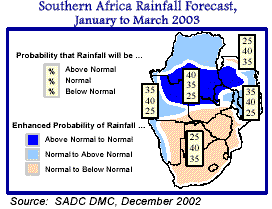
|
The forecast is based on probabilities derived from 30 years of historical rainfall data, and considers the state of the global oceanic-atmospheric system and its implications for the region. Climate experts caution that the forecast is for aggregate rainfall over the three month period and for relatively large areas, therefore local and month-to-month variations should be expected.
The forecast has been influenced by the current El NiСЃo, which typically indicates dry conditions for southern Africa. However, the current El NiСЃo remains moderate and is significantly less than the 1997/98 El NiСЃo. According to the International Research Institute for Climate Prediction, the negative impact on rainfall is also expected to be less than in 1997/98, but could be substantial in some areas . El NiСЃo conditions are expected to persist through the end of the season.
|
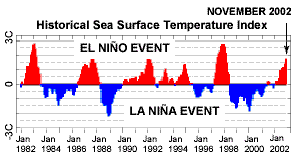
|
FURTHER ANALYSIS CONFIRMS LIKELIHOOD OF REDUCED YIELDS FROM 2002/03 SEASON
USGS FEWS NET has released a report highlighting the inverse relationship between October rainfall levels and late-season rainfall in southern Africa. Based on historical data, the USGS analysis shows that when October rainfall is above average (as occurred this season) January rainfall that follows is always drier than average. On the basis of this study, USGS concludes that a dry spell is likely to occur during the second half of the season. They note that this analysis relates to regional trends, and that local trends might not follow what has been observed as a region-wide phenomenon.
The USGS through FEWS NET, in collaboration with the SADC RRSU, has released a forecast on likely end-of-season maize crop performance based on likely rainfall performance. The model uses the Water Requirement Satisfaction Index (WRSI), which estimates the percentage of a crop's total seasonal water requirement that is met from available rainfall and soil moisture. For most of the crop producing regions included in the analysis (see map), the forecast suggested modest reductions in crop yield compared to normal. Based on this analysis most of the region could have near normal yields, with the exception of northern South Africa, southern Mozambique and northern Namibia, where yields are most likely to be below normal. This analysis is associated with a fairly high level of uncertainty but indicates that it is most likely for yield levels to range from slightly above normal to well below normal. It is also important to bear in mind that this analysis is based purely on the Water Requirement Satisfaction Index and does not consider
other factors that affect production, such as input availability.
|
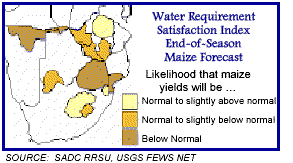
|
LARGE REMAINING CEREAL GAPS IN SOME COUNTRIES WILL BE DIFFICULT TO FILL
|
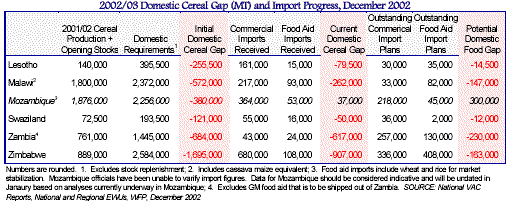
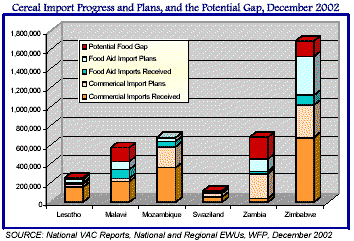
|
Large remaining cereal gaps in some countries could be difficult to fill before the end of the marketing year based on import progress and plans to-date. Of particular concern are Zambia and Zimbabwe. Zambia has made the least progress towards filling its cereal gap, having received less than 10% of its import requirements. Food aid imports to Zambia have been slowed by the government ban on GM maize. According to available data, Zambia currently faces a cereal gap of 617,000MT. Current commercial and food aid import plans, even if fully met, would fill only 63% of this remaining gap, although it is unlikely that these plans will be fully achieved based on past import performance.
With a 907,000MT cereal gap remaining, Zimbabwe faces the greatest challenge. Current food aid import plans, if realized, would reduce the gap to 500,000MT. Although government plans to import an additional 336,000 MT, there is concern about government capacity to import this quantity due to foreign exchange and other constraints. Even if all planned imports are received, which is considered unlikely by many analysts, Zimbabwe would still face a sizeable cereal gap of 163,000MT.
Although reported imports to Malawi have so far filled 54% of estimated needs, there remains a sizeable gap of 262,000MT. Current import plans, if achieved, would reduce the gap by only 44%. Preliminary information from Mozambique indicates they have already received more than enough imports to fill their cereal gap, with additional commercial imports still expected. Lesotho has imported more than two-thirds of its requirements, and Swaziland nearly 59%.
STAPLE MAIZE PRICES VARY ACROSS THE REGION, INCREASING IN MOST MARKETS
The graph (below) presents a comparison of November 2002 maize prices in the six affected countries. The map (below) allows comparison of price trends over the past year for those countries where time series data was available. Local prices have been converted to US dollars to allow comparison.
|

|
Reported maize prices are currently highest in Lesotho, although a large variation exists in different parts of the country. Cereal prices in Lesotho are currently increasing at a rate of almost 80% per year. Although whole maize is not subsidized in Lesotho, un-sifted maize meal is reportedly subsidized at 50% to help meet the food needs of poor communities.
Maize prices in Malawi are increasing as household stocks are depleted and more people rely on the markets. Overall, prices are slightly lower than they were last year at this time, and the rate of increase is slower than a year ago. Current prices are lowest in the north near the Tanzania border and are highest in central parts of the country.
In Mozambique, rapidly rising food prices in Maputo are raising concern over the threat of urban food insecurity. Prices in northern cereal producing areas are lowest, although prices are as much as 27% higher in northern inland areas close to the Malawi border compared to northern coastal areas.
Swaziland reports little variation in maize prices across the country. Current maize prices are as much as 80% higher than last year at this time.
Maize prices across Zambia vary according to availability, with lower prices reported in urban and northern areas. In areas affected by food shortages, prices in November increased by as much as 23% over the previous month.
In Zimbabwe, government price controls on basic staple foods have led to serious shortages of maize and other commodities across the country. Some of those who have access to available maize supplies from the Grain Marketing Board reportedly purchase at the low controlled price, and then resell in black markets at prices more than 100 times higher. Analyzing staple maize prices is complicated by the side-by-side existence of controlled prices (Z$12.50/kg) and local market prices (currently averaging Z$130/kg), and the official exchange rate (set at Z$56/ USD) and the parallel exchange rate (Z$1,500/USD). Depending on the combination of rates, one kilo of maize could cost less than US$0.01 (controlled price, parallel rate) or as high as US$2.32 (local price, official rate). These price differentials offer clear opportunities for unscrupulous traders to make large profits by purchasing and reselling staple food commodities both within Zimbabwe and across borders where prices are notably higher. However for most Zimbabweans across the country, staple foods and other basic commodities remain largely unavailable.
|
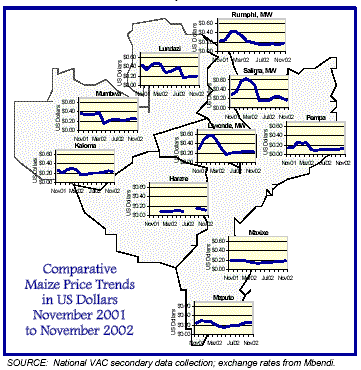
|
|






